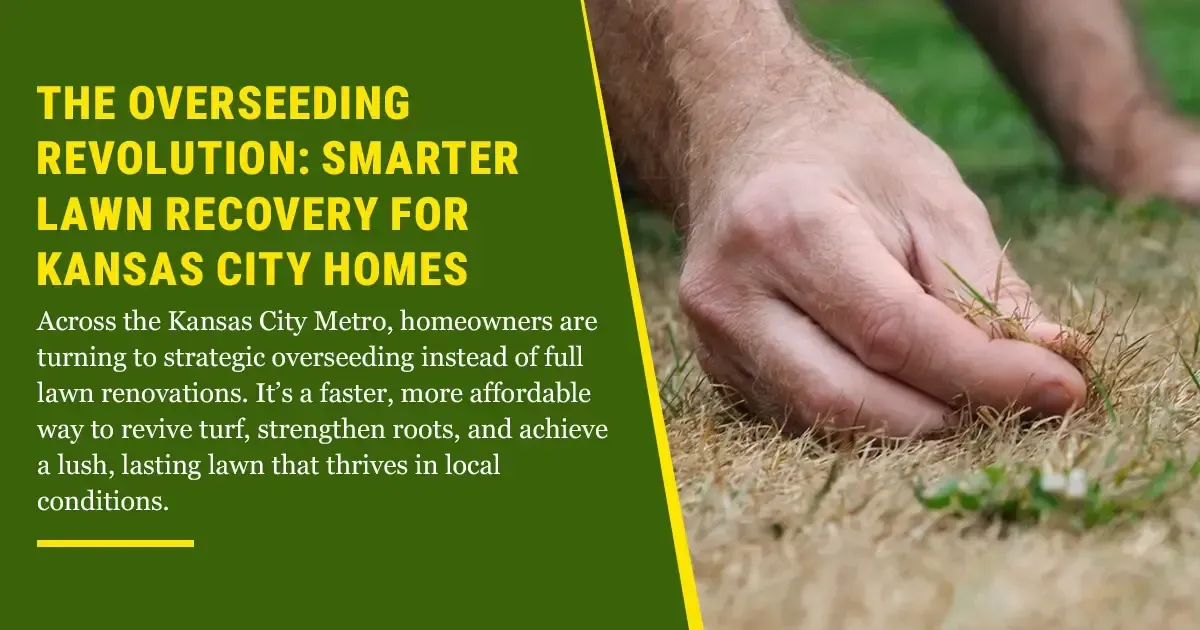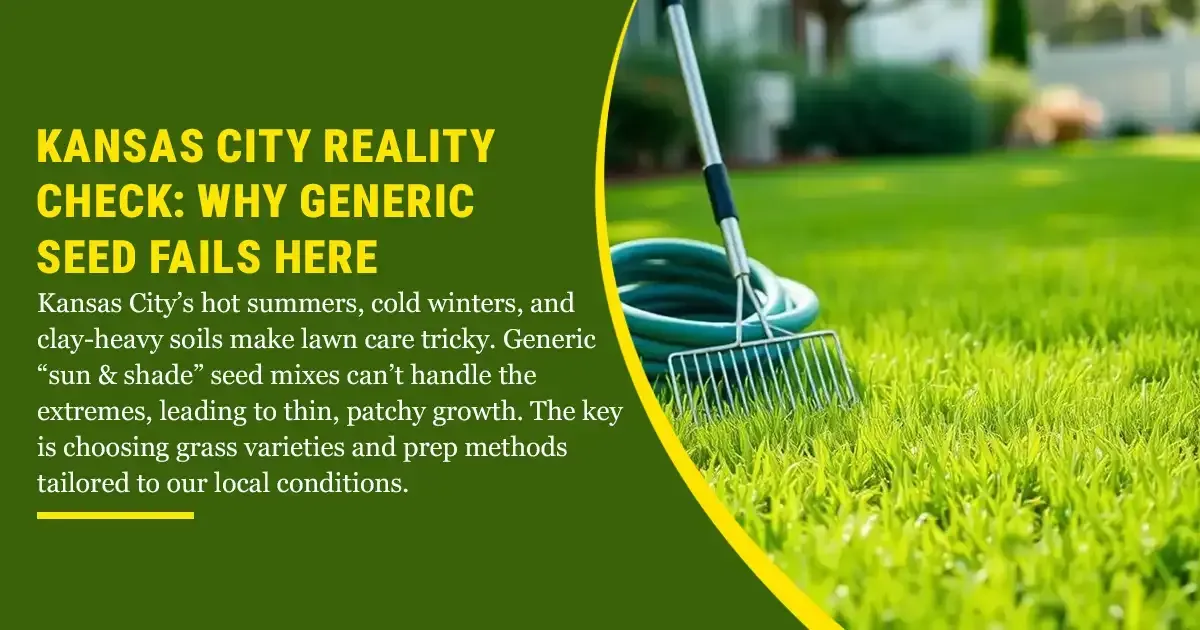October 8, 2025
At Lawnscape Specialists , we see the same problem every fall and spring across the Kansas City Metro—homeowners buy “one-bag-fits-all” seed mixes and then wonder why the lawn struggles. The truth is simple: choosing seed that matches our climate, our clay-heavy soils, and your sun/shade patterns does more for lawn success than any single product. This guide distills how pros pick seed in the KC transition zone so you can avoid bare spots, reduce water waste, and enjoy a thicker, greener yard. Kansas City Reality Check: Why Generic Seed Fails Here The KC Metro sits in the transition zone , where summers are hot and winters are cold. That makes grass selection trickier than in strictly cool-season or warm-season regions. Add our common clay soils and mixed sun/shade yards, and generic “sun & shade” mixes rarely perform well. A locally tuned plan—seed type + soil prep + timing—wins every time. First Principle: Match Seed Type to the Transition Zone For most Northland homeowners (Parkville, Riverside, Gladstone, Liberty, Platte City, Weatherby Lake, Smithville), cool-season grasses dominate—especially tall fescue blends with supporting varieties where needed. Warm-season options can work in select scenarios, but cool-season fescues provide the best balance of durability, appearance, and water tolerance for typical residential properties. Tall Fescue (recommended base): Deep roots, handles heat better than many cool-season grasses, and responds well to overseeding. Perennial Ryegrass (supporting): Quick germination for coverage while fescue establishes; good for play areas that need fast recovery. Fine Fescue (select shade areas): Useful where filtered light dominates; integrate sparingly according to shade patterns. When warm-season makes sense: Full-sun, high-heat sites that homeowners want to mow lower and keep very heat-tolerant may consider bermuda or zoysia; however, establishment and winter appearance expectations should be discussed first. Soil Comes First: Clay Strategy for KC Lawns Clay soils can pool water, compact easily, and make root growth difficult. The fix isn’t just buying “premium” seed—it’s creating a seedbed that roots can actually grow through. Core Aeration: Relieve compaction and open channels for air, water, and roots. See our program overview here: Lawn Care (6-Step Program) . Verticutting/Seed-to-Soil Contact: For overseeding or new sections, vertical grooves improve germination and stand density. Details on verticutting and overseeding are included on our Lawn Care page above. Topdressing (where needed): Lightly amend with screened compost to improve structure and moisture balance without smothering seed. Sun vs. Shade: Map Your Light, Then Mix Smart No single seed blend excels everywhere. Walk the yard and label zones: Full Sun (6+ hours) , Partial (3–6) , and Filtered/Heavy Shade (<3) . Then match varieties accordingly. Full Sun: Tall fescue backbone, optional ryegrass for fast cover in play areas. Partial Shade: Tall fescue with a modest fine-fescue component. Heavy Shade: Turf struggles under <2 hours direct sun. Consider mulch beds, groundcovers, or hardscaping for the best long-term look and cost control. Pro tip: Blend by area, not by bag. It’s common for KC lawns to need one blend in front (sun) and another in back (shade). Traffic & Lifestyle: Choose for Kids, Pets, and Pathways Seed selection should reflect how you actually use the space. For play sets, dog runs, and common paths, tough tall-fescue-based blends—optionally with a touch of perennial ryegrass—recover better from wear. Reserve fine-textured ornamental looks for lower-traffic, showcase areas. Timing That Works in Kansas City Prime overseeding window: early–mid fall when soil is warm and air cools—ideal for root growth before winter. A secondary window exists in early spring, but fall produces better summer resilience. If you’ve missed the fall window, talk to us about spring adjustments and watering plans that keep seedlings safe as temperatures rise. Premium vs. Budget: What You’re Really Paying For “Premium” isn’t just a label—it usually means tested varieties suited to Midwest conditions, cleaner seed, and more consistent performance. Budget mixes often include short-lived species or filler that look good fast but thin out when heat, foot traffic, or summer stress arrive. Over a few seasons, reliable establishment and density typically out-save the initial discount. Your KC-Smart Seed Blueprint (Step-by-Step) Evaluate the yard: Note sun/shade zones, traffic lanes, drainage, and any thin or compacted areas. Prep the soil: Schedule core aeration and verticutting to relieve compaction and improve seed-to-soil contact. Choose the base: Tall-fescue-based blend for most homes in Parkville, Riverside, Gladstone, Liberty, Platte City, Weatherby Lake, and nearby Northland communities. Customize by light: Add a fine-fescue component in partial-shade sections; introduce a small ryegrass fraction where quick early cover is important. Overseed correctly: Calibrate spreaders, overlap passes lightly, and water to keep the top 0.5–1 in. of soil consistently moist until germination and early rooting. Protect the investment: After establishment, use deep, infrequent watering to train roots down; mow tall fescue ~3–3.5 in. to shade soil and discourage weeds. KC Troubleshooting: If the Stand Looks Thin Compaction spots: Pets and play areas may need an extra aeration pass and a touch of ryegrass for speed. Wet pockets: In clay, low spots may stay wet after storms; improve grading or use micro-swales to move water. Shade lines: Under trees, reduce competition with selective pruning for light and leaf litter management; blend in more shade-tolerant fescue where needed. When to Call the Pros If you’ve overseeded before and still fight thin turf, the issue is rarely “bad luck.” It’s usually a stack of small mismatches—seed type vs. light, seedbed vs. clay, or timing vs. weather. Our team can evaluate the property, recommend the right blend, and handle aeration, verticutting, overseeding, and weed control on the right schedule for the Kansas City climate. What About Pests While New Seed Establishes? Grubs, mosquitoes, and other pests can complicate establishment and outdoor use. If you’re seeing mole runs, summer grub patches, or heavy biting pressure that keeps you off the lawn, ask about our pest control services for a comfortable, usable yard while your turf fills in. Bottom Line for the KC Metro A thriving lawn in the transition zone isn’t about luck—or a miracle product. It’s about aligning the right seed with our climate , treating clay soil constraints , and timing establishment for durable roots. Make those choices up front and you’ll spend less time reseeding and more time enjoying a yard that handles heat, traffic, and seasons the Kansas City way. Ready to Pick the Right Seed (and Get It Done Right)? Let’s walk your property, choose the correct blend for each zone, and schedule the services that set the lawn up to win. Explore our Lawn Care (6-Step) approach for overseeding, aeration, and weed control. See pest solutions if insects or moles are undermining your results. Serving the Northland and greater Kansas City Metro. Ready for a tailored plan? Call 816-284-8097 or request a quote today.










